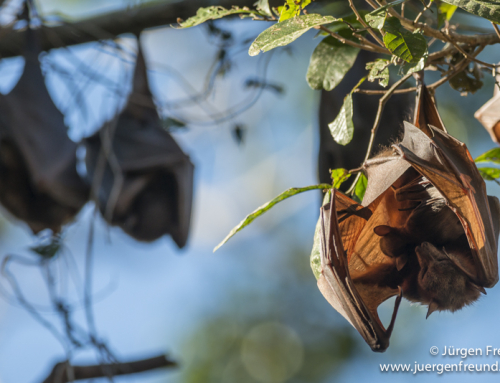Many thanks to Tansy Bliss’ text below, we are able to tell you through her writing and Yogi’s photos how brilliant this local NGO is at the heart of Kimbe Bay, West New Britain. Tansy is a naturalist and the Eco-tourism Officer of Mahonia Na Dari.
By Tansy Bliss
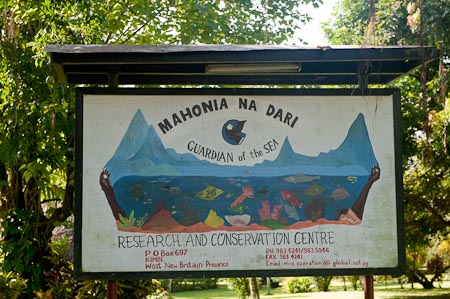
The Mahonia Na Dari sign before you enter their complex
Mahonia Na Dari Research and Conservation Centre is a small, locally managed non-governmental organisation based in Kimbe Bay, West New Britain. It was set up back in 1998 and over the years has gradually developed to meet the needs of the local community. On its doorstep is a marine ecosystem with some of the highest biodiversity and best diving in the indo-pacific region.
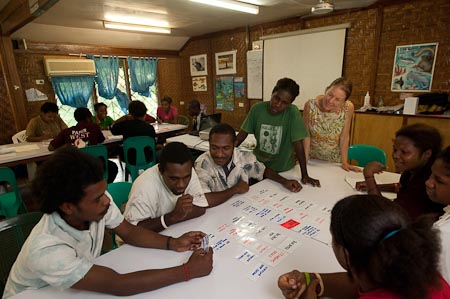
Standing (R-L) are teachers Tansy Bliss and Lorna Romaso. The lesson for the day to 16 level 12 students is all about Coral Reefs
Mahonia Na Dari’s vision is to protect this unique marine environment through raising awareness and educating future generations about what they have and how it functions. This is achieved most effectively through a series of semi structured 10 week, 1 day courses attended by selected students from the secondary schools in the area. This Marine Environmental Education Programme (MEEP) has been running now for over 10 years. The learning is focused around integrated resource management and interrelated ecosystems supported by the fundamentals of marine ecology and biology. The students also learn new skills; how to snorkel, take comprehensive field notes, lead and participate in discussions and present information in interesting and stimulating ways.
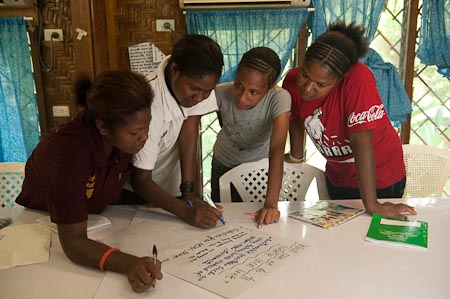
A round robin question and answer activity was all about the reef. They also found out about the dangers that lurked behind marine animals with powerful stings
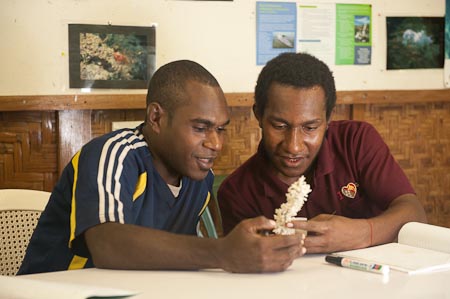
The students analyze the anatomy of a coral and this skeleton of a branching coral makes their mind wonder about the mysteries of the reef
They leave with confidence and a desire to make a difference to their world by sharing information and ideas and taking action at a local level. One of the early students from the 90’s recently returned as a teacher, bringing her own students to the course because she believed it made a difference to her life and how she wanted to live.
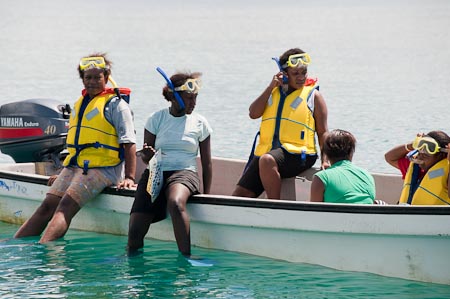
Teacher Lorna Romaso leads a group of 16 students to snorkel and learn about the reef
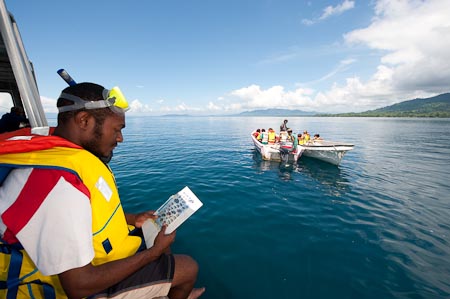
Preparing to get into the water, a Mahonia Na Dari student prepares his photo guide slate and snorkeling gear

Lorna skillfully duck dives with her student to show and tell the nature of a coral reef. After a few hours classroom session about branching corals, here now is the real thing!

The students write down in their waterproof slates the corals and fish life they have just seen underwater
Mahonia Na Dari also offers a Marine Excursion program and schools can come for 1-5 days and tailor the program to suit their needs.
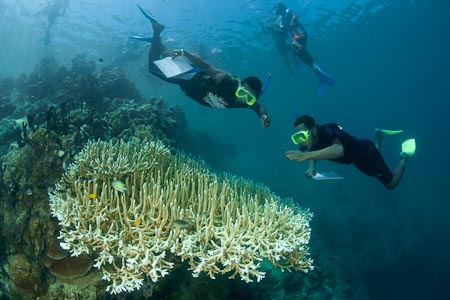
The best way for these students to learn is to see and experience the marine life in the very waters they own
Some want practical sessions on reef survey and data collection techniques, others want the students to live and learn the experience through drama and role play and some come to use the well resourced library with its wide selection of books, videos and DVD’s.
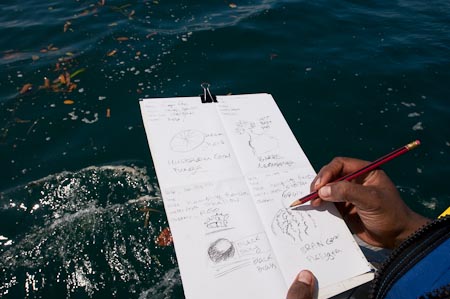
This is how one of the student’s slate looked like after 2 hours snorkeling in the site called Hanging Garden
It is the Research arm of Mahonia Na Dari, mainly co-ordinated by James Cook University in Australia, that provides the background information and data that supports and verifies the need for sound resource management. As their understanding of the marine eco-system increases so too do the options for better management.
This information needs to get to the resource owners and where appropriate, be put into action. This happens mainly through working with the Locally Managed Marine Area (LMMA) committees who are responsible for implementing marine management plans for their own particular groups of reefs and supporting eco-systems. The LMMA concept is supported by Mahonia Na Dari and The Nature Conservancy as it links into the Kimbe Bay network of Marine Protected Areas which forms part of the coral triangle initiative.
The stimulus for the formation of Locally Managed Marine areas comes from increased awareness about the reefs and what is happening to them. Once again Mahonia Na Dari has a role to play. It trains marine educators from the communities who then run awareness programs in the villages, targeting any key concerns that have been identified. Language barriers are removed as “tok ples” the local language, replaces tok pisin and a full and rich dialogue develops.
Gradually over the years, Mahonia Na Dari has also come to recognise that whatever happens on the land affects what happens at sea. Oil palm plantations dominate the coastal landscape. The associated economic boom has brought significant in-migration putting additional pressure on the marine resources. Logging in the headwaters of catchment areas may be contributing to sedimentation, there is soil erosion from traditional gardening on steep unprotected slopes and rivers and streams are depositories for domestic and human waste which eventually ends up in the sea.
In the eco-system based approach to management, now being adopted by key aid agencies and the PNG Government, everyone has a role to play. Mahonia Na Dari’s contribution is by providing opportunities for increased awareness, quality education and research that will lead to local action at a local level.
For more information please visit our website www.mahonianadari.org

When we were all nice and dry, the Freund Factory gave the MEEP students and teachers a WWF Coral Triangle slideshow presentation. And a group picture taking afterwards was certainly not to be forgotten!
If you want to keep updated with our new expedition blog entries, please sign up to our RSS feed by clicking here or clicking on the “Subscribe to this blog!” link at the top right of this page.
And to look up past entries, go all the way down and click into << older posts. Or go to the Archives on the upper right column of this page.

